Military unit: Royal Naval Reserve (HMS Pebble)
Date & place of birth: 18 June 1884 at Southampton
Date & place of death: 2 February 1917, aged 32, at sea off Mudros, Greece
William Sharland was an engineer with Union Castle Line who was commissioned into the Royal Naval Reserve. He was on board HMS Hythe when she was involved in a collision in October 1915, with a large loss of life. He took his own life on board HMS Pebble in February 1917.
Family
William Wellington Sharland was born on 18 June 1884 at Wilton House in Orchard Place, Southampton, the first son of William Edward Sharland (1842–1895) and his wife Julia née Newsam (1851–1923).
William Edward Sharland was from Redbridge and was the eldest son of William Row Sharland (1813–1900), a coal merchant originally from Broadhembury in Devon, and Rebecca Hewett (1813–1891).
William and Rebecca had married in Fareham in 1839 and had six children. In July 1885, 72-year old William Row Sharland filed a petition for the restitution of his “conjugal rights” but Rebecca counter-claimed that William had regularly beaten her, and applied for a judicial separation. By 1891, the pair were living apart with William at 4 Compton Walk in the Nichols Town area of Southampton and Rebecca in Ryde on the Isle of Wight with her youngest son (a coal merchant like his father) and his wife.
Prior to his marriage, William Edward Sharland was a commission agent by profession. On 17 January 1884, aged 42, he married 33-year old widow Julia Newsam in Portsmouth. Julia was first married in September 1870 to Walter Oakley, a retail fruiterer and florist who traded from 118 High Street, Southampton. Walter died, aged only 33, in 1880, leaving Julia with four children under 7 years old.
After Walter’s death, Julia continued to trade as a fruiterer until her marriage to William on 17 January 1884. Their first child, William Wellington Sharland was born on 18 June 1884, followed by a daughter, Mabel Victoria on 30 September 1885.
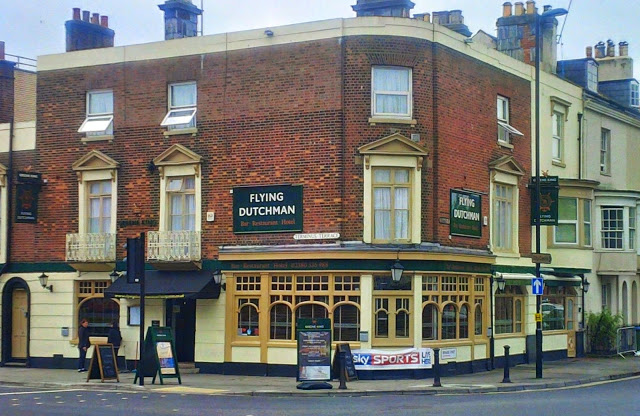
In September 1886, William Edward Sharland was described as the landlord of Parkers Hotel (on the corner of Bridge Street and Terminus Terrace, Southampton) when he appeared in court as a witness in a case against his brother-in-law, James Hatcher, formerly landlord of the Cliff Hotel, Woolston. The two men had been involved in a fracas in Oxford Street when Parker threatened to “corpse” William in a dispute about a debt. The case against Hatcher was dropped after he apologised and agreed not to molest William in future.
In January 1887, William was back in court, this time as the accused, when he was charged with assault against Jane Giblett, a neighbour of Parkers Hotel. Mrs Giblett had come out into the street after she heard cries of “Murder!” and saw William dragging Julia by the neck. She tried to intervene, when she was struck in the mouth. William explained to the court that the blow was intended for Julia, rather than Mrs Giblett, as she was pulling on his ear with such force as to cause it to bleed. The magistrates were persuaded that they should ignore “any knowledge they might possess of the unhappy domestic relations between Mr & Mrs Sharland” and agreed that there was no malice in the assault, which was an accident. As a consequence, a custodial sentence was inappropriate and William was fined 46 shillings (£2.30) and costs.
In April 1887, William was in court once again charged with being drunk at Parkers Hotel, and of threatening to take the life of Julia, now described as the landlady of the public house. The row had arisen because Julia had commenced divorce proceedings, and had refused to withdraw her action. The fight started in the bar in front of several customers when William, who had been drinking heavily, pushed Julia down and then pulled her by the hair. Although she called the police, who briefly took William into custody, he was released that same evening and returned home. The fight broke out again, although there was no further violence, merely verbal abuse in “the most filthy language”. William was imprisoned for one month and required to find sureties totalling £50 and to be bound over to keep the peace for six months.
On 21 May 1887, Julia filed her divorce petition at the High Court, with a request for a judicial separation on the grounds of William’s drunken and violent behaviour.
Despite this, the couple remained together, with William continuing the cycle of drunkenness and violence. Sadly, William was back in court in January 1888 following a series of assaults in November, including one against his own solicitor, as well as a drunken rampage through the bar in which he smashed several beer glasses and some crockery. When Julia left the pub to take a cab to see her lawyers, William pulled her out into the street in front of the children, tearing off her jacket. She attempted to take another cab, when William jumped in on top of her, before pushing her out onto her face. At the trial, Julia pleaded for leniency, explaining that she wanted her judicial separation and not to be molested again. The magistrates agreed to impose a shorter sentence, despite this being a second offence and William was sentenced to 14 days in prison with hard labour. The court also agreed to the Judicial Separation and awarded Julia custody of her children under 10.
Despite the magistrates agreeing to the separation, the family were still together at Parkers Hotel at the time of the 1891 census, with William giving his occupation as commercial traveller and Julia as “licensed victualler (pub)”. Living with them were the couple’s two children and Julia’s three youngest children from her first marriage, plus two live-in staff.
William Edward Sharland died of cirrhosis of the liver, aged 53, on 13 October 1895 at his father’s home in Compton Walk, Nichols Town. Four months later, on 15 February 1896 at Biggleswade in Bedfordshire, Julia, aged 45, married for the third time, to Andrew Graham Liston, nine years her junior. Andrew Liston, from Stirling in Scotland, was a marine engineer employed by the Union Steam Ship Company.
Following Julia’s marriage to Andrew Liston, she and her family were able to settle into relative peace and prosperity. In September 1895, 11-year old William started his secondary education at King Edward VI Grammar School, shortly before the school moved premises from Bugle Street to Havelock Road, Marlands in Southampton. In June 1899, in the annual school prizegiving, William was a recipient of the Third Form prize. The following year, he was awarded the Fourth Form prize.
After leaving school, William continued his education as an evening student at The Hartley Institute (later Hartley University College). In November 1902, he received a prize in Machine Construction.
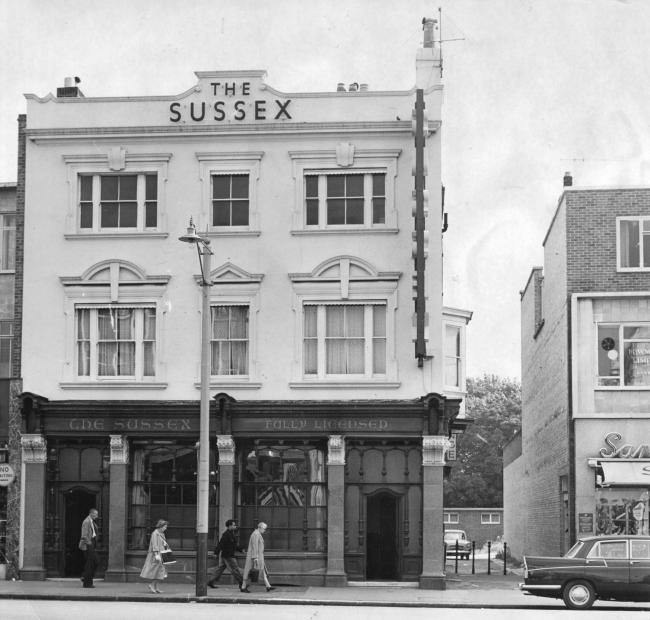
By the time of the 1901 census. Julia had left Parkers Hotel and became licensee at the Sussex Hotel, which stood in Above Bar Street, north of the junction with Pound Tree Road, opposite Ogle Road. The census records Julia living with her husband, Andrew Liston (marine engineer), her married daughter Emily McHugh, and her youngest children, William and Mabel, plus one guest and five staff. 15-year old William is not shown with any occupation.
Ten years later, Julia and Andrew were living at Clairville, 6 Archers Road, Southampton with their 11-year old grandson Louis McHugh and three servants. Although Julia was recorded in the 1911 census as having no occupation, she is still listed in the 1911 Kelly’s Directory as the licensee of the Sussex Hotel. The census records Julia’s son, Ernest Oakley as the manager of the Sussex Hotel, with her other son by her first marriage, Percy Oakley, being the licensee of Parkers Hotel. William Sharland is not recorded in the 1911 census.
Masonic career
Andrew Liston was a Freemason, who was initiated into Lodge St John Dalmuir No 543, Scottish Constitution, and joined Southampton’s Lodge of Peace and Harmony No 359 on 20 May 1889. He does not appear to have attended regularly and was removed from the lodge register in 1898.
William’s half-brother, Percival Arthur Oakley, was initiated into Woolston’s Clausentum Lodge No 1461 in December 1904.
30-year old William Sharland was initiated into Lodge of Peace and Harmony No 359 on 20 July 1914, alongside 46-year old master mariner, Edwin Smith. William was passed to the second degree on 17 August 1914 and raised to the degree of Master Mason on 21 September.
Service with the Merchant Navy and Royal Naval Reserve
It is probable that after leaving school, William entered into an apprenticeship as a marine engineer, although no records have been traced.
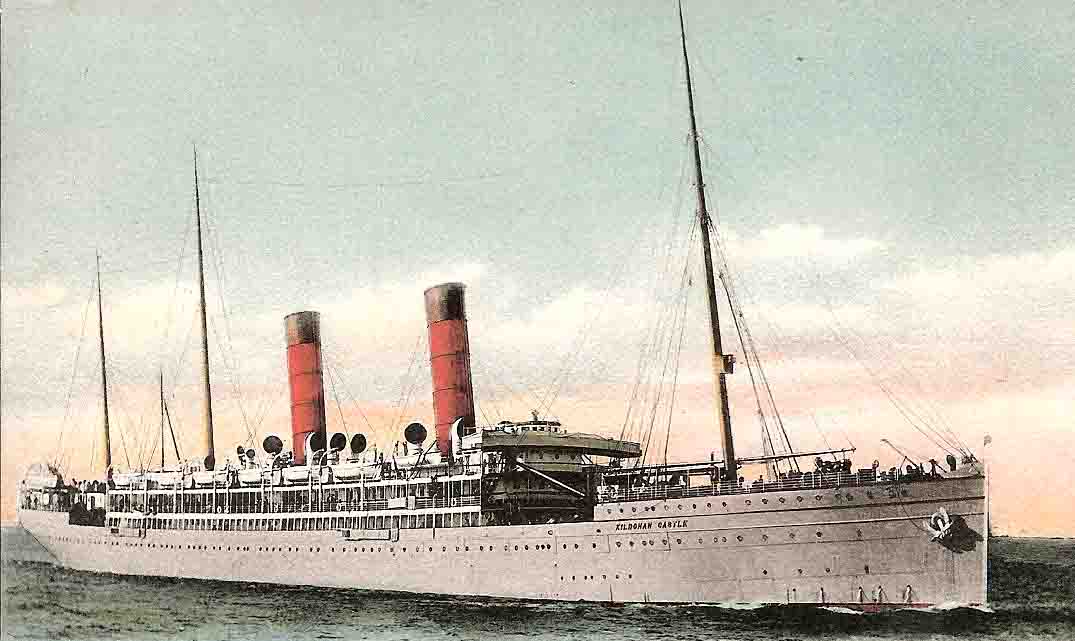
On 13 November 1909, aged 25, he is recorded as the 8th Engineer on the SS Kildonan Castle. The Kildonan Castle, a 9652 ton screw steamer was built in Glasgow in 1899 for the Castle Mail Packets Company (Castle Line), but was requisitioned before she was fully fitted out for use as a troop ship in the Boer War. After the war, she was refitted as a passenger liner with 250 First Class, 200 Second Class and 136 Third Class cabins for service with the Union Castle Line between England and South Africa from December 1901.
On 29 December 1914, William was commissioned into the Royal Naval Reserve as a (Temporary) Assistant Engineer, following which he was transferred from the Kildonan Castle to HMS Hythe as Second Engineer.
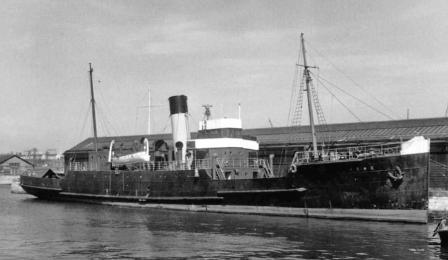
SS Hythe had been built in 1905 for the South East and Chatham Railway Company for the cross channel (Dover-Calais) service. She was a 509 ton cargo carrying steamer, with no passenger accommodation, which had been commandeered by the Royal Navy and converted to a minesweeper in October 1914, when two 12 pounder guns were fitted. She was originally intended for service off the north coast of Scotland, but later in 1915 she was sent to the Mediterranean for use as a troop carrier, taking men into the beaches at Gallipoli.
On 28 October 1915, HMS Hythe was in Mudros Bay off the Greek island of Lemnos when she took on board 5 officers and 213 men from the 1st/3rd Kent Field Company, Royal Engineers, together with 30 other personnel. Hythe had no passenger accommodation, so the men had to remain on deck, while the officers were able to occupy the engine room. To protect the men from spray and the weather, a large canvas awning was rigged on her deck. Hythe left Mudros Bay at 4 p.m. bound for Cape Helles on the southern tip of the Gallipoli peninsula, some 50 miles away. Four hours later, in the darkness, she was half an hour from the landing beach. To avoid detection from the enemy, all lights had been extinguished.
At 8:10 p.m. she collided with HMS Sarnia, a 1498 ton former LSWR passenger ferry, which was steaming away from the beach after disembarking her troops. The collision caused the foremast on the Hythe to fall onto the fabric awning, trapping many of the men as Hythe sank. The Sarnia rescued several men from the sea, but 129 members of 1/3 Kent Field Company were lost plus 15 other Army personnel and 11 crew from the Hythe.
Full details of what happened to William Sharland during the sinking of HMS Hythe are not available, but it is probable that he was rescued from the sea. On 7 November, an entry was made on his records:
“T.L.’s [Their Lordships (of the Admiralty)] appreciation expressed of creditable conduct on occasion of collision between “Sarnia” and “Hythe”.
In the Easter 1916 issue of Sotoniensis, the King Edward VI School magazine, there is a brief mention of William:
Engineer-Lieut. Sharland had a lucky escape when the Majestic was sunk. He is said to have been in the water several hours before he was rescued.
HMS Majestic was torpedoed off Cape Helles on 27 May 1915, with the loss of 49 men. There is no record of William Sharland serving on HMS Majestic and it is assumed that the editor of the magazine must have confused the two ships.
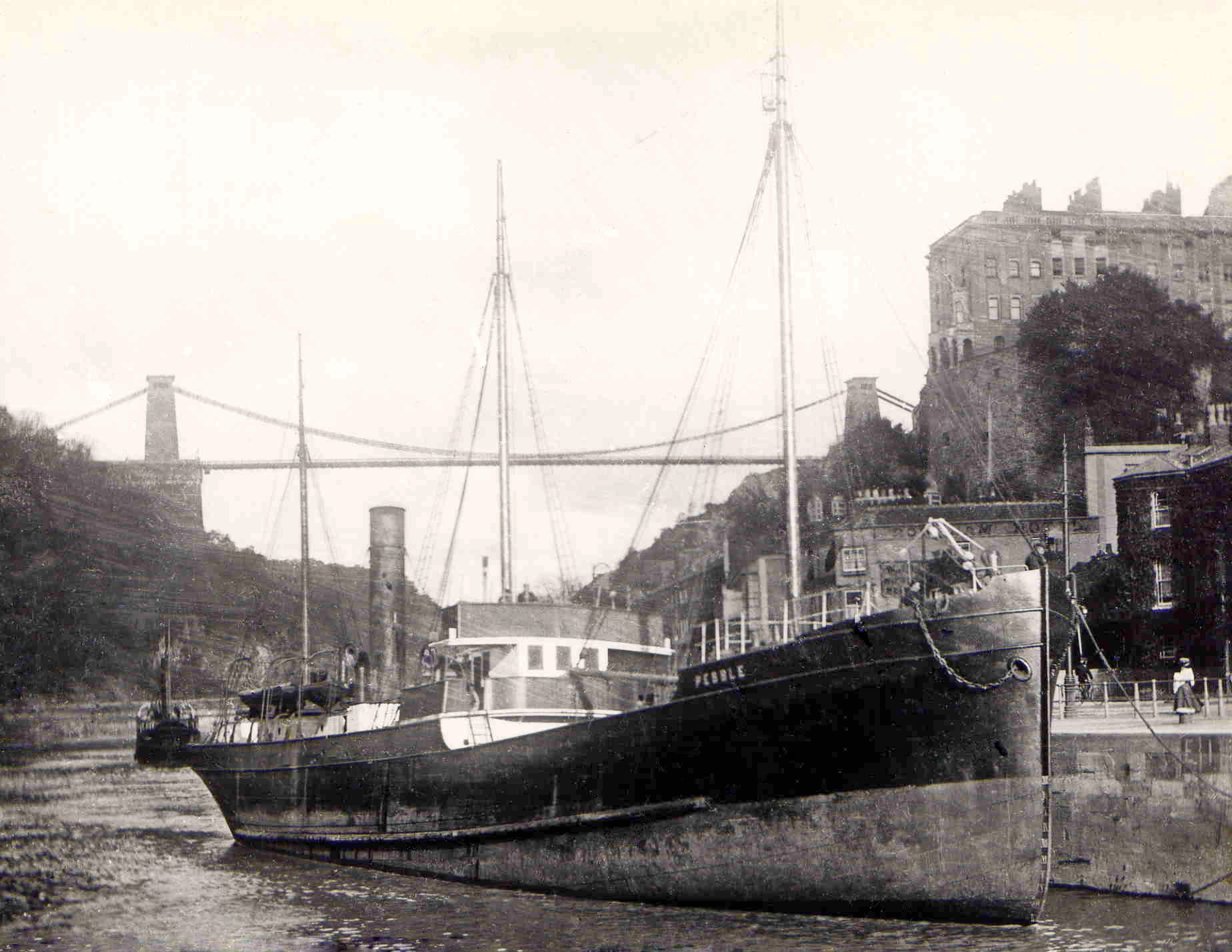
On 8 January 1916, William Sharland was appointed as 2nd Engineer on the Fleet Messenger HMS Pebble, with the rank of Engineer Sub-Lieutenant. Launched in 1890, Pebble was a 477 ton coaster built for William Robertson & Co of Glasgow. In July 1915, she was requisitioned and sent to the eastern Mediterranean as a Fleet Messenger, whose role was to carry parcels, reports and despatches that could not be signalled due to their size, together with bags of fleet mail to the sailors that had arrived from the UK and other small auxiliary duties.
Death and commemoration
Although the failed Gallipoli campaign ended in February 1916, HMS Pebble remained in the eastern Mediterranean. In May 1916, her captain, Lieut. John B Carmichael RNR, received a ‘Mention’ in the London Gazette for good Transport Services at the Dardanelles. William Sharland was promoted to Engineer Lieutenant on 16 October 1916.
On 2 February 1917, William Sharland died from a haemorrhage, after he cut his own throat. No record of an inquest appears to have survived and it is not known what circumstances led to William taking his own life.
He was buried at East Mudros Military Cemetery in plot III. G. 197.
He was posthumously awarded the 1914–15 Star, the British War Medal and the Victory Medal.
In October 1917, probate was granted to his solicitor, Edwin Gulliford. William left an estate valued at £1923.
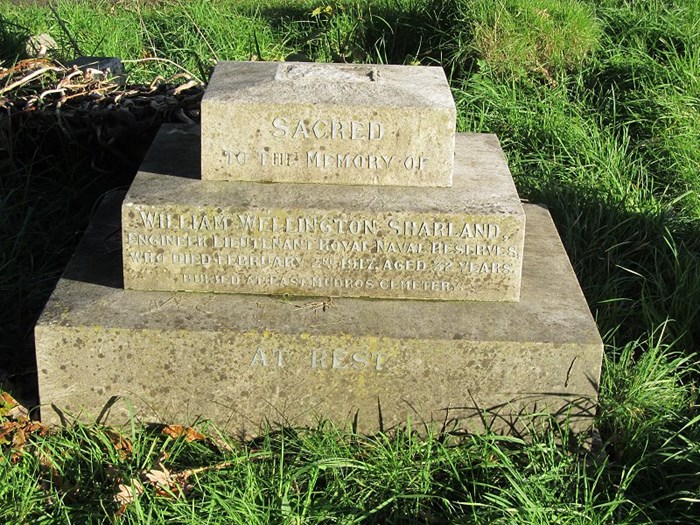
As well as the Masonic Roll of Honour, he is commemorated on the Cenotaph in Southampton’s Watts (West) Park and on the King Edward VI School War Memorial. He is also remembered on a family plot in the Old Cemetery in Hill Lane, Southampton.
Other family members & subsequent family history
William’s stepfather, Andrew Liston joined the Royal Naval Reserve at the start of the war as Chief Engineer on HMS Kildonan Castle. In October 1915, she was commissioned as a hospital ship, before being converted into an Armed Merchant Cruiser the following year as part of the 10th Cruiser Squadron. Andrew was mentioned in dispatches in September 1918, and awarded the O.B.E. in the 1919 New Year’s Honours. He left the RNR in February 1919, with the rank of Engineer Commander.
Andrew Liston died on 16 January 1921, aged 60. His widow, Julia, died on 11 December 1923, aged 72. She left an estate valued at £44838.
Sources
Ancestry.co.uk
1891 England Census
1901 England Census
1911 England Census
England & Wales, National Probate Calendar (Index of Wills and Administrations), 1858-1966, 1973-1995
United Grand Lodge of England Freemason Membership Records, 1751–1921
UK, British Army and Navy Birth, Marriage and Death Records, 1730-1960
UK, Naval Medal and Award Rolls, 1793-1972
UK, Navy Lists, 1888-1970
Bitterne Local History Society: List of Names on the Cenotaph
The Broad Arrow. 8 January 1915. Royal Naval Reserve
CLIP database:
Clyde Ships: SS Kildonan Castle
CWGC Casualty Details: Sharland, WW
Find a Grave: William Wellington Sharland
Great War Forum: Lieutenant William Wellington Sharland (HMS Pebble)
Hampshire Advertiser:
5 January 1887. An Unlucky Blow
21 January 1888. Bad Domestic Revelations at Southampton
23 October 1895. Deaths: William Edward Sharland
7 June 1899. Southampton Grammar School. Prize Distribution
2 June 1900. The Grammar School. Prize Distribution at Southampton
29 November 1902. The Hartley College. Distribution of Prizes
21 January 1921. Funeral of Mr. A.G. Liston
9 June 1923. Grammar School. Old Boys War Memorial
Hampshire Chronicle:
18 September 1886. Plot to Murder a Brother-in-Law
30 April 1887. A Husband Illtreating and Threatening his Wife
9 November 1889. Assaulting and Threatening a Wife
Hurd, Archibald: History of The Great War – The Merchant Navy, Volume 1
Imperial War Museum, Lives of the First World War: William Wellington Sharland
King Edward VI School, Southampton:
London Gazette:
5 January 1915 Issue: 29030 Page: 150
31 December 1918 Supplement: 31099 Page: 112
Masonic Roll of Honour: Engineer Lieutenant William Wellington Sharland
The National Archives:
ADM 137/3136: Collision between H.M.S. Sarnia and H.M.S. Hythe
ADM 240/39/309: William Willington Sharland. Rank: Engineer Lieutenant (Temporary)
ADM 240/45/343: Andrew Graham Liston. Rank: Engineer Commander (Temporary)
BT 400/3744/15. Ship: Hythe; Official number: 120504
Naval History.net: HMS Kildonan Castle
Roll of Honour: SS Kildonan Castle
Southern Echo (Southampton). 29 February 1896. Marriages Liston – Sharland
Further reading on sinking of HMS Hythe
1915crewlists: Crew List Document for Vessel ‘Hythe’
Historical RFA: Requisitioned Auxiliary – Sarnia
Johnson, Judith: The Sinking of HMS Hythe – 28 October 1915
Kent Fallen: The H.M.S Hythe Disaster
Passey Family History: War Diary 1/3rd Kent (Fortress) Field Company, Royal Engineers
Photograph credits
Flying Dutchman pub: Pubs and Beer in Southampton
The Sussex Hotel: Daily Echo
SS Kildonan Castle: Clyde Ships
SS Hythe: Historical RFA
HMS Pebble: Historical RFA
Gravestone: Lives of The First World War